
|
|
|
Search our site
Check these out    Do you have an entertaining or useful blog or personal website? If you'd like to see it listed here, send the URL to leon@pawneerock.org. AnnouncementsGive us your Pawnee Rock news, and we'll spread the word. |
Too Long in the WindWarning: The following contains opinions and ideas. Some memories may be accurate. -- Leon Unruh. Send comments to Leon June 2008Cedar tree, how big it grows
Cedar at Pawnee Rock State Park. [June 30] We all have our favorite trees. Perhaps your favorite tree, like mine, is associated with a childhood memory, such as picking cherries in the summer sun. Elms and cottonwoods were all around us, but for all the shade they provided they weren't very interesting to me. Redbuds were pretty in the spring. Catalpas had enormous leaves and drew flocks of crows. Locust and Kentucky coffee bean trees had their long brown seed pods, and locusts provided the additional thrill of thorns. Any young boy can find a dozen uses for nature's sharp instruments. But if I were going to pick a tree to decorate my plains with, I'd choose the cedars found in churchyards and shelterbelts and at the cemetery and on Pawnee Rock State Park. Maybe these cedars are tame versions of eastern red cedars, a native species found in our township's pastures and shelterbelts. You know the red cedars, the ones with the juniper-smelling blue berries and the scratchy needles. The cemetery cedars, trimmed of branches near the ground, have the proper sense of aridity for Pawnee Rock's climate, yet they're an oasis for insects and lichens. The bark can be almost velvety to the touch, and it peels off in long strips. Cut with a saw, the limbs reveal a purple underlayer. Predator birds don't like the cedars, but songbirds do. And, to the annoyance of my wife, that sappy Bobby Goldsboro song "Honey" ("See the tree, how big it's grown . . .") lends itself to frequent parody by me. Below is a view, taken by Jim Dye in April, of native cedars in the pasture north of the salt plant ruins. Birds spread the seeds; unbothered by fire or plow, the cedars are taking root in more of the dry uplands.
Sailors take warning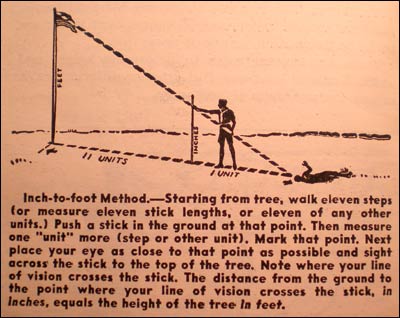
[June 29] The weekend's wet weather in Pawnee Rock stirred me to look into how I learned a reliable method of forecasting -- "Red in the morning, sailor take warning. Red at night, sailor's delight." Pawnee Rock, of course, is pretty far from the shores where such wording was created. But the lore translates well to the dusty plains, where Kansans' lives are also directly affected by wind and rain. From the moment I learned the saying in grade school, I've judged every evening and morning by this aphorism, and it has served me well. Of course, my weather education has grown more sophisticated, but being able to read clouds and knowing about dry air (producing a red sky) in the morning have practical value when my comfort and safety depend on correctly reading the weather.
As I spent time with one handbook and reminiscing about Troop 444, I came to the page that taught me how to tie my old nemesis, the bowline knot, and other pages that taught me how to measure tall things and how to measure things with what I have at hand, literally. These measurement instructions are illustrated here. Inspired back then by the finger-section rule of thumb, I started looking for other common measuring tools and discovered that a quarter has a diameter of 1 inch, that ballpoint pens are almost always 5 1/2 inches long, and that a dollar bill is just over 6 inches long. To this day, I measure many items and file away the dimensions in case one day I'm stranded without a ruler and all I have handy is a cellphone (4 inches long), pocketknife (2 5/8 inches), or shoe (11 1/2 inches). I know that such knowledge is considered increasingly archaic in these days when people buy things rather than make them and velcro fastens as many shoes as do strings. Still, I like to think that in the one future moment when it really counts, I'll be prepared in ways that only a Scout can be.
Harvest memories[June 28] Barton County expatriate Ray Randolph remembers wheat harvest: "Even now, almost fifty years later, I can put myself right back into the driver's seat of a big old truck as I pull alongside an even bigger moving combine and match its speed as the golden kernels spew into the bed of the truck. The combine operator then gives me a wave and I either wait another few minutes to complete the load, or pull across the field and onto the dirt road and head for the farmyard and the Butler bin or go to the CO-OP elevator. And do this until the wheat field is nothing but stubble or the combines quit long after dark. "Memories." A photo I like: No. 93
[June 28] In the novel and movie "Jurassic Park," dinosaur DNA was collected from blood-engorged mosquitoes trapped in amber. Amber is fossilized tree sap. Tree sap is still with us, and so are skeeters. So the next time you give blood to a mosquito, consider the possibility that that bug is going to get trapped and 65 million years hence be uncovered by a scientist who will reconstruct you and put you in a park for dangerous creatures. This photo was fun to make, despite the obvious insult to my finger. I wanted to see how much of my blood I could photograph inside the mosquito. I didn't intend to let her get away, but she had her fill of me before I was prepared to squish her. And so I donated my DNA to the great preservation fund. That's one possibility. Another is that she lived well enough off this blood to create several generations -- millions -- of mosquitoes, one of which will find and deliver a disease that eventually will send humans the way of the dinosaurs. If that's the case, I apologize. Otherwise, I'll see you in 65 million years. The cutting edge[June 27] For a couple of weeks each June, we would listen to the radio for wheat-harvest reports first from Sumner County, along the Oklahoma border, and a few days later from Seward and Radium, Larned and St. John. How high was the protein? Was the wheat dry? How many bushels to the acre?
The custom cutters, at least in my day, brought fresh blood to town. Some of the crews had been through town for years, hired by the same families. The crews had a few high school guys, and the girls in Pawnee Rock always seemed to find a way to parade past the hard-bodied boys in their seed caps and blue chambray shirts. The grain trucks lined up at the elevators to be weighed and have the wheat tested, and then they lined up to dump their wheat, and then they lined up to be weighed again. The elevator's office was open as late as the farmers would cut, and the grain dryer ran night and day; I don't know how the families across the street put up with it. But it meant money. This was the payoff for a year of work and worry. After this, the farmers relaxed and bills were paid. Sure, there were milo and corn and soybeans and hay and alfalfa yet to bring in, but wheat was king. Rolling back the years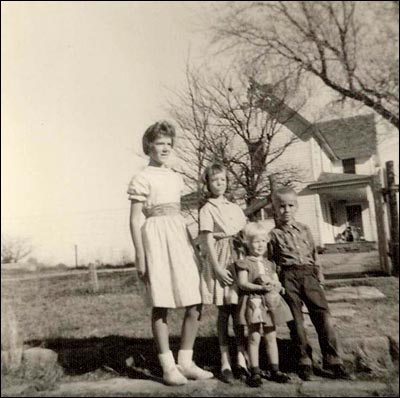
Cousins Cynthia, Mary, Cheryl, and Leon in the early 1960s at the farm. [June 26] Last evening before we walked the dogs, our son Sam amused himself by doing somersaults down the slope in front of our house. Nik wanted to do it too. Although he knew the moves, his head just wouldn't tuck under and he got himself into awkward headstands before falling over sideways. I stood there coaching him. Bend your neck, I said. Push yourself over. Watch how Sam does it. Looking at the boys brought back to mind summer evenings north of Pawnee Rock when the folks and Grandma and Shep the farm dog sat on Grandma's porch and we cousins messed around in the yard while we waited for the lightning bugs to come out. We played tag and did as many gymnastic tricks as we could think of. My sister, I think, did cartwheels; I didn't have that knack but I could do a suitable somersault. What we all did well was collect chiggers. There's a truism that we adults think of ourselves as being 15 years younger than we are. When it comes to remembering somersaults, however, don't we all imagine ourselves to be 10 years old and willing to roll until we are dizzy enough to throw up? I'm guilty of that. Nik wanted me to show him how to roll, so I climbed up the slope and tied our husky to a birch. I went to my knees, tucked my head under, and felt a sudden lack of faith in my ability to find the ground on the other side. "Come on, Dad," the boys said. "Are you afraid?" No, I wasn't afraid. In fact, just after we wrapped up our exercise we walked the dogs down our usual path and apparently strolled right past a bear in the woods (according to a couple of men shouting to us after we rounded a corner of the trail). Being an old tornado hunter, I craned my neck to catch sight of the bear instead of getting the boys and dogs to a safe place immediately. No, I'm not afraid. There I was on the grassy slope, frozen like a beginner on a diving board. Well, the kids were watching, so I went for it. I tucked my head, I imagined my heels-over-head flight and landing, and kicked off. My legs went straight up, and after an ungracious moment I fell over on my side and rolled laughing into the ditch. "They weren't even straight up," Nik said later. Tomorrow I'm going to sneak into the back yard and practice my somersaults. I'll pretend it's a crepuscular evening on a dryland farm and there's no one watching but the barn swallows and Shep. I'll show the boys how it's done, and then they'll have another story to pass along to their kids one day. Honor for a student; request for help[June 25] The inbox collected a couple of unusual e-mails recently. One from Bethany College recognizes a star student from Pawnee Rock, and the other is a call for help by an artist in Lawrence. Nicolette Unruh of Pawnee Rock is one of 150 students named to the Bethany College academic dean's honor roll for the spring semester. Ms. Unruh, a junior, has a semester grade-point average of at least 3.5 on a 4.0 scale, the press release from the Lindsborg school said. Students from elsewhere in Barton County who made the list are Brianna Kaiser, a junior from Hoisington; Kendra Lemman, a senior from Great Bend; and Shane Reif, a senior from Hoisington. Students from Larned who made the list are Emily Bowen, a junior; Afton Eye, a senior; and Anika Eye, a junior and, like Ms. Unruh, a cheerleader. Joelle Ford, who I've never met, needs Pawnee Rock's help with a fun project going up in Lawrence. Here's her message: "I am working on a project to be shown at the Lawrence Arts Center, December 2008, that utilizes advertising pens and pencils from towns in Kansas. The title will be 'Wave the Wheat.' Do you have a pen or pencil with Pawnee Rock printed on it that you would like to contribute to my work? They could be from any Pawnee Rock business, organization, charity, etc. "If you have pens or pencils from other towns and places in Kansas, I would of course be delighted to receive those as well. "I appreciate any help you may give!" When I wrote back to get her mailing address, she added that she's looking for about 800 pens or pencils for the project. You can mail your writing instruments here: Joelle Ford, 1723 East 1100 Road, Lawrence, KS 66049. Her e-mail is joelle_ford@yahoo.com. The Mennonite colony of Dundee
[June 24] We've all driven through little Dundee a million times on our way to Great Bend. It used to have many more people -- and kids who went to Pawnee Rock schools -- but the population has dwindled considerably, and cars and cattle trucks aren't even required to slow down anymore as they whip through town. For today, however, let's pull over in that wide spot just north of the long grain shed and consider Dundee's early history. The following description of the area's Mennnote colony comes from the "Biographical History of Barton County, Kansas," which was published in 1912.
Nevertheless, this report presents an interesting description of people who became important to our hometown. I'm related to some of them, and you may be as well. If nothing else, what follows lets us examine the thinking of our German-accented ancestors. THE MENNONITE COLONY NEAR DUNDEEShortly after the completion of the Santa Fe railway through Barton County, in the spring of 1875, that company through its emigrant bureau extensively advertised its lands throughout all sections where it was possible to reach those seeking new homes, and this literature was scattered broadcast over sections of Russia and agents were stationed in New York to meet and guide them to this locality. By these means a large proportion of the present population of Barton County were induced to settle and improve the lands to their present state of productiveness, and became factors in making this county what it is today. That these people had long been in search of a land in which to make their homes is proven by their past history which is that in 1802 their ancestors emigrated from Germany to Russia on an agreement with the Empress of Russia that they were to make their own laws and govern themselves in a limited way for ninety-nine years; be exempt from military duty and be free in religious observances. When their descendants left Russia for America this period would soon expired and they left rather than submit to the laws that would soon be forced upon them, the adoption of the Greek Catholic religion, and service in the Russian army. The majority of those who settled here had lived in small communities or villages in Russia and were weavers, lumber sawers and farmers by trade. They had been supplied by companies stationed at a distance with the material and work, and had depended more on this means of subsitance than on that of agriculture. To govern such a village it had been found necessary to form themselves in a compact body with a responsible head, and that manner of organization was at first attempted here by the colony which settled one mile east of the present town of Dundee. There were fifteen families in this colony, and they entered the whole of section 16, under the homestead act, and bought the whole of section 9 from the Santa Fe railway Company on payments covering eleven years. Both sections were divided originally into twenty equal parts and this gave to each family a tract of thirty-two acres on each section; or sixty-four acres in all. On section 16 they built houses out of 4x6 lumber and there made their homes and gardens, and on section 9 they pitched their crops.
Those who made up the village are the families of Cornelius D. Unruh, (deceased), Cornelius Thomas, (deceased), Henry Seibert, (deceased), Christian C. Schultz, Mrs. Lizzie Rudiger, Andrew L. Unruh, Jacob Seibert, (deceased), Benjamin Unruh, (deceased), Andrew B. Unruh, first schultz, (deceased), Peter Unruh, Cornelius P. Unruh (deceased), Andrew A. Seibert, living in Marion County, Mrs. Susan Unruh, (deceased), Benjamin P. Smith and Peter H. Dirks. Henry B. Unruh also purchased his first home from this colony, but as he was not a resident until March, 1876, is not included in the original settlers. It will also be seen that the original intentions of the community were never carried out as the plans were for twenty families and only fifteen came under the agreement. The scheme was found impractical in this country after about three of four years trial and the various members became better acquainted with the freedom of the laws in America. As their holdings were independent of their village agreement they finally decided to become in fact free American citizens and one by one sold their first little homes and bought larger and better farms in other localities and are now classed among Barton County's most substantial and best citizens. At that date there were other German-Russian settlers in this same and other localities in the county, and the Santa Fe system and other railways realized that they were of the proper make-up to make good citizens and provided emigration houses along their lines. There was one at nearly all depots for the accommodation of these new arrivals and in these they settled temporarily, lived while they provided permanent homes for their families. Where these houses were not yet built box cars were often put to use for temporary homes, and it was in a car on a siding in Pawnee Rock that Jacob P. Dirks, of "Mount Pleasant Hillside Farm" was born, and in an emigrant house at Newton, Kansas, that Jacob A. Dirks, of "North Slope Farm," first breathed the breath in free Kansas. The vacation journey
Ingrid the stuffed beagle competes in the backyard Monster Jam. [June 23] My right shoulder is sore, my bottom doesn't care to see a railroad seat again for several weeks, and the grass still isn't mowed because of all the rain. All in all, this past week has been a good vacation. My shoulder is sore because I was showing off to my younger son as we walked the family dogs. With the big dog and a full poop bag in hand, I led him up a sidewalk that a sprinkler was straddling. Being an obstinate fool, I figured the perfect revenge would be to walk through the offender's yard instead of strolling a short distance in the street. The yard is 10 feet below the sidewalk. "Let's cut down this hill," I said just before Buddy pulled hard and my feet slipped out from under me, whacking me hard to the slope. Nik, who a couple of months ago was there when my wife broke her leg skiing down a hill, instantly perched near my head, asking whether I was OK. I was in a bit of shock. I checked for broken bones and mentally scanned the neighborhood to figure out whether anyone might have seen me. Yes, I told Nik. I'm OK. My right arm broke my fall, and three days later it's sore. Nik got hours of amusement from his discovery that the dogs' poop bag had been popped by my hip. (He just finished fourth grade, but even I admit that it's funny.)
In a place where run-of-the-mill motel rooms cost $250 a night, a hamburger runs $10.95, and tourists come from around the world to savor the tundra, the boys found their greatest pleasure playing in the rocky banks of the Nenana River. Sam propped up a flat rock, put a long stick next to it and played rock music on his "guitar." Nik built what he called "an Alaska sand castle'' -- a log cabin made of willow twigs and leaves. On Saturday, the boys staged races on the back deck with 11 "monster trucks" that Nik had created out of cardboard boxes, construction paper, and Tinkertoy wheels. The boys put their stuffed dogs in the trucks and ran them over obstacles for two and a half minutes a whack. I scored their efforts, judging on speed, jumps, and imagination. Yesterday, Sam and I drove into Anchorage for a tour of the city's port, which had been off-limits to the public since 2001. Now the port is looking for public empathy and money for expansion, so all summer it's inviting people in for a short, highly secure bus tour of the docks and storage yards in the narrow space between the military installations and Cook Inlet. Back in the happy days, we used to drive through the port frequently so the boys could see the cargo containers be lifted or driven off the huge ships from Tacoma. On Sunday, Sam barely remembered any of that, but now he has watched the giant cranes place containers on trucks and learned how the operators climb out to their tiny cabs. On the port's viewing deck, I introduced Sam to former Governor Bill Sheffield, who now runs the port. Our present governor, Sarah Palin, was there, too. She had brought her own clutch of kids to see the ships; I overheard her tell Sheffield that she wanted them to understand where things came from. People love to be around Governor Palin. She has an 80 percent favorable rating in statewide polls, is a model of rectitude, and has been featured in national magazines; her only detractors seem to be the old-guard Republicans she displaced and who now comfort themselves around the AM radio cracker barrel.
Then Sam and I drove out to the airport to watch 747s take off, and finally we went out along the inlet to look for whales and eat ice cream. So, did I have a classic vacation? I didn't go anywhere I hadn't been before, and I certainly spent a lot of hours at home working on books. The boys and I did several things that they'll remember for years, and it was all created by making the most out of what was available. We didn't have a destination, really, but we certainly had a journey. It reminds me of summer vacation during our school days in Pawnee Rock, when we had nothing to do but never ran short of things to do. Along the railroad tracks[June 22] When Leon Miller was a young fellow, his dad ran a fuel distributorship with tanks along the south side of the highway and along the tracks. It's easy to imagine how Leon, who lived on South Centre Street, could spend a lot of time messing around there. "When I was a young teenager back in the 40s, the Santa Fe Railroad had a group of stockyard pens located on the south side of the tracks about 200 yards east of the depot. "To entertain ourselves a group of us boys created a game we called 'stockyard tag.' There were maybe 6 different pens with wide gates at one end of each pen and the trick of the game was to elude the person who was IT, by running along the top of the pen, across the gate and then shove the gate back away from where you had just jumped from. "Many an hour was spent on this enjoyable sport despite the potential danger of falling off the top and breaking an arm or a leg. I don't recall anyone ever getting hurt from this pastime -- a far cry from today's occupation of Game Boys and X-Boxes."
Here's what he wrote: "Is the sign on public property or is it still RR property? "If public, is there a preservation project possible and/or the possibility of maybe another sign--a new one that would carry on the tradition and recognition of Pawnee Rock. A sign that would also complement the prairie skyscraper on the other side of the tracks/road." (Alas, the sign is gone. I looked through some photos I made 18 months after I shot the sign and found that it was absent. But I like Ray's idea for a sign that evokes the railroad days.) 
The site of the former Atchison, Topeka and Santa Fe depot in Pawnee Rock. A photo I like: No. 92
[June 21] This sign for decades announced to rail passengers and locomotive drivers where their good fortune had landed them, but the Santa Fe Railroad depot platform they would have stepped onto was long gone when I made this photo in October 2003. Photos of this sort are an amusement, because they are freighted with so much (too much) symbolism. Does the sign show the Faulknerian decline of a hamlet back into the soil? Or is it an emblem of how a town refuses to dry up and blow away despite Kansas' evaporative winds? Does the wooden cross harken back to William Jennings Bryan, the Nebraska populist of a century ago who said that America's working poor were being crucified on a cross of gold? A fourth choice is that the Pawnee Rock sign is an old friend from my childhood. I was overjoyed to find that our sign hadn't been picked clean by scavengers and that I once again could lean against the 4x4 post in the golden light of an autumn sunset. The sign indeed is a symbol of Pawnee Rock's decline and of rural Kansas' hard times over the years as the railroad backed away. And yes, of course, it is also a symbol of our hometown's perseverence. Pawnee Rock has changed over the decades, but our small city of sandstone buildings, frame homes under the elms, and things that exist only in our memories is tough, and it's ours. The day the sun stands still[June 20] Welcome to summer. Today is the longest day of the year, when the sun "stands still," which is what solstice means. In 1988, the sun did stand still. At least, it must have seemed to be stuck in the sky -- the high temperature was a record 108 degrees. Today will be the year's longest day, with the sun above the horizon at Pawnee Rock's latitude (38.3 degrees) for 14 hours 50 minutes. Sunrise was at 6:12 a.m., and sunset will be at 9:02 p.m. With the just-past-full moon, there will be plenty of light all night -- and what could be better for fishermen and romantics on a warm weekend night? Tomorrow, the long slide into winter begins. Saturday will be 1 second shorter than today. Time off from work[June 17] There comes a time in every man's life when he just has to take a vacation. For me, that's this week. My vacation from the newspaper started Monday. I'm also going to step away briefly from PawneeRock.org, so the site's not going to change for a couple of days. Thanks for your patience in the interim. I hope you'll flip through old photos or otherwise have fun on PawneeRock.org, and of course you're welcome to patronize our advertisers. (I've always wanted to use that line, borrowed from the small papers I used to work for in central Kansas.) My vacation started on the same day that our economically stressed newspaper chain took back the jobs of 1,400 workers, including a few at the Wichita Eagle and more than a hundred at the KC Star. My newspaper lost about three dozen employees, including several in my department; they were given severance pay and two more weeks on the job. I have been looking forward to this vacation for 52 weeks, but I feel bad about not being in the office while so many of my friends bore through their final workdays and figure out how to handle their immeasurably more difficult lives. But I'll be back with you all later in the week. Be good. Record what's important[June 16] A couple of very nice e-mails arrived this weekend from Barbara Schmidt and Ray Randolph. Barb (PRHS Class of 1969) wrote in praise of Jim Dye's Arkansas River photo of Saturday and of Saturday's "A Photo I Like" posting. "Today's postings were especially joyful -- that picture-perfect photo of the Arkansas River and then 'Sam & Nik Go to Kansas' -- what a hoot!" Ray, an author himself, wrote: "Such a neat book for the boys. It's something they can treasure." I'm grateful to hear such kind words from friends of Pawnee Rock, and I'm sure Jim is too. I encourage you all to create projects like my little book. The format isn't important, but I do recommend something that the kids or grandkids can hold and associate both with their own memories and with you. Our family was fortunate to have a vacation trip to build the book around, but it could easily be about Pawnee Rock or where you live now, or a weekend trip to see family members, or even a special event like a birthday party. It could be photos of you going about your life, illustrating the stories you want to pass along. I used Quark Express to lay out the book's pages and Photoshop to work the photos, but any programs that do that kind of work would be perfect. A lot of photo-sharing websites can help make albums. Our kids don't pay much attention to the book right now, because they're busy making the most out of each fresh day. But when they're grown up, they'll have a chance to reflect on their adventure and our family. They'll see what we thought was important enough to record for their future. The real gift of the day
[June 15] I've been a dad myself for 12 years, the shortest dozen years of my life, and I've come to my own conclusions about fathers. First, I have a pretty good dad, Elgie. He taught me a lot about Pawnee Rock and how to deal with life. He took me fishing and was patient when I needed it. As far as I remember, his father, Otis, was a good guy, too. I know almost nothing but historical facts about Otis's father, Peter A.R. Unruh, and I assume he was a decent man because I've never heard otherwise. Second, we dads do the best we can. Some have a knack for parenting, and others work at it with varying levels of success. Frankly, some dads are better than others. Dads are always in the news and angry memoirs for the evil they create, but for every one of those there are a thousand who try to make their children happy and safe and smarter. Like most dads, I want to spend more time with the boys, but sometimes that's hard to arrange and they don't need good ol' Dad hovering like a helicopter. When we do go for a drive or walk the dogs or even shop for groceries together, I feel like a king because I have Sam and Nik with me. In fact, just thinking about that makes me smile. Third, we dads are imperfect. I know, and my dad knows, and all dads know that we have cut a corner here and there, that we've been selfish or fraudulent or in some other way undeserving of that coffee cup labeled "World's Best Dad." No matter how many testimonials the kids provide over the years -- hand-written and drawn cards at first, then earnest handshakes and Hallmark cards emblazoned with ducks, sailboats, baseball gloves, and golden retrievers -- we're not eligible to become saints. Mothers, of course, become saints the moment they give birth, and that's OK. Moms are the ones remembered in a son's tattoos. Dads understand that. The best part of today is not what comes in an envelope or a cardboard box wrapped in hunter-green paper. The real gift of Father's Day is that our family is willing, for this one day, to overlook our faults. 
A photo I like: No. 91
[June 14] Back in 2000, my wife went on Biking Across Kansas. Because we had moved back to Alaska the year before, we flew to Kansas City, rented a minivan and drove to Kanorado to drop her off. And then I escorted the boys on a weeklong exploration of Kansas as we all made our way east to White Cloud. The boys, age 4 and 2, played in parks across Kansas and got their first taste of Dairy Queen. A kind farmer near Frederick let them "drive" his brand-new John Deere combine because they were from Alaska, and Ruth Deckert let the boys climb into her wheat truck because they were my boys, and we stopped in plenty of fields so the guys could see what cattle and corn really look like. When we got home, I turned our trip's photos into a 36-page book with maps and doggerel: "We are brothers Sam and Nik. / We are going for a ride. / Daddy drives across the state, / Eight days to the other side." And so on. 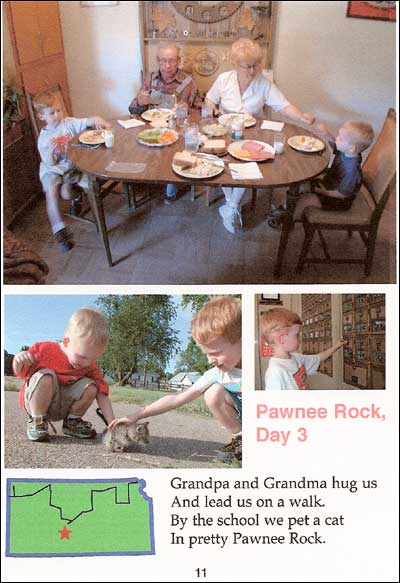
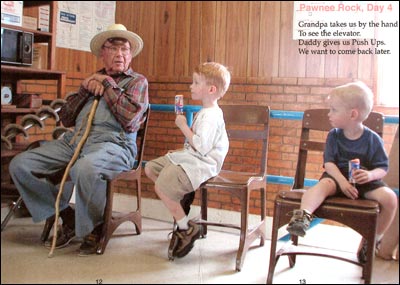
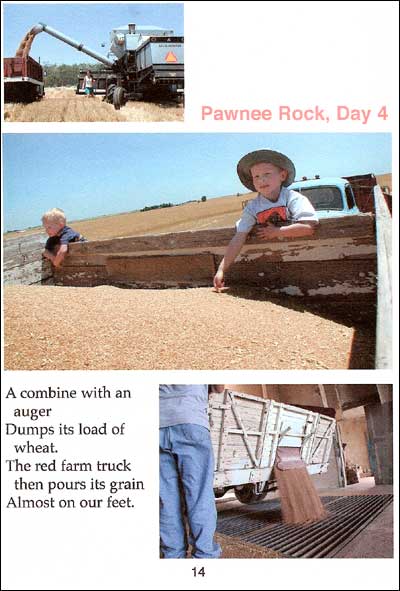
Biking and basketball across Kansas[June 13] This is the week of Biking Across Kansas, as you surely must know if you subscribe to a Kansas newspaper. As the sun beats down on the plains and prairie and as storms whip across it, 800 or so cyclists are making their way to Missouri. The route this year is along the northern edge of the state. They started last Saturday at Colorado west of St. Francis and will end up this Saturday in Atchison, where they'll dip their wheels in the Missouri River. I rode last year with our sons, and I would liked to have gone again. My vacation schedule and the expense of getting there weighed against it this year. You might expect that the endless cycling is the best part of the ride. Or that mingling with friends is the best part. If you're of a particularly Kansas bent, you might get the most joy out of looking at the weeds growing in 500 miles of ditches. But there's more to the ride than I expected my first year. This part of June is also the National Basketball Association championship week, and the current games pitting the Boston Celtics and the Los Angeles Lakes bring to mind my first two BAK rides, back in 1984 and 1985 when the Celtics and Lakers played each other. I think we must have been in Sterling in 1984 when a bunch of us swarmed into a bar to follow the midweek game. Having grown up in Pawnee Rock, I was cautious about settling into a drinking hole in a town where someone from home might see me, but the bartender opened the doors wide for thirsty cyclists with cash. Our week on the road reliably provided us with two or three games. I don't remember who won the specific games, but I do enjoy the memory of sitting back in leafy towns in the middle of Kansas watching Larry Bird and Magic Johnson compete. That was a true vacation. Four seek township offices[June 12] Four residents of Pawnee Rock Township are standing for election in the Barton County primary election on August 5. As they're all unopposed, look for them also on the general election ballot November 4. The Pawnee Rock Township candidates are all Republican, too, but that's not unexpected. In all of Barton County's 88 primary races, only 21 candidates have identified themselves as Democrats. There are only four contested races, and they all are Republican. Here are the candidates, according to the Barton County Clerk's office, with their names as you'll see them on the ballot: • Township trustee: Dale D. Dirks. Previous election results are available. The Schmidts are up for re-election. The wilderness of the mind[June 11] A psychologist who shows up frequently in my reading is Abraham Maslow. Maslow was famous for laying out the concept of self-actualization, which says that people fulfill stages of development on their way to a successful life. This process starts out with physiological needs -- having food and shelter -- and marches on through the need for safety, the need to be loved, and the need for esteem. At the end of this parade is self-actualizing behavior, which basically means that the individual is creative and has a good grip on the world. Whenever I come across Maslow's hierarchy of needs, my mind -- certainly an egotistical entity -- insists on daydreaming about my struggle. This battle against ancient forces is always fought in the same place. You've been there, figuratively and literally. It's the stretch of unplowed flood plain between the Arkansas River and Ash Creek, ending at the Point. Why do I have to go back to those ghostly cottonwoods? Maybe I got lost out there one night in junior high and it made a deep and repressed impression on me. Maybe it's because I walked hand-in-hand there with a sweetheart one summer day and was too shy to kiss her, and my mind has never forgiven me. It is the wildest place around Pawnee Rock. The property may have a fence around it and a dusty track for pickups, but it's mainly home to deer and raccoons, mushrooms and bullsnakes. If you whacked your leg with a hatchet out there -- in the days before cell phones -- you could be dead before you dragged yourself through the willows to the county road. It was the perfect place for a youngster to build his little fire and cook his supper in an aluminum pot, the perfect setting for a cheap pup tent to stand against the animals that patrolled the deep night of central Kansas. Some of the animals had four legs. Others had two legs, a case of beer in the pickup, and their own loudly expressed need to be loved. There were nights indeed when the Point was a wilderness. I loved it, but obviously the Point and I still have issues. Rudolph Boese, successful young farmer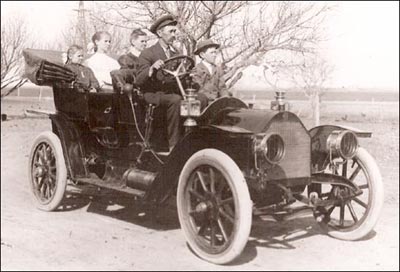
Mr. and Mrs. John Boese, with daughters Grace and Louise and one of their sons, go for a drive in their Chalmers automobile. The boy in the front seat may be Rudolph. [June 10] The Boese family has long been a part of the Dundee settlement and Pawnee Rock churches and schools. This following biography, first published in the "Biographical History of Barton County, Kansas" in 1912, describes Rudolph Ludwig Boese, a born-in-America son of immigrants John and Julia Boese. The Boeses may have been Mennonites, but they liked machinery. They apparently were quite proud of their Chalmers automobile. Rudolph Ludwig BoeseAmong the younger farmers of Barton County none is better known for their progressive methods and enterprise shown in the cultivation of the soil, than the subject of this sketch, Rudolph Ludwig Boese. He was born September 7, 1887. His parents were John and Julia Boese, who came to America from Poland-Russia. His father first settled in Ohio and after remaining there two years came to Barton County, where Rudolph was born. His mother first settled in Pennsylvania and came to Kansas in same year as her husband. He has one brother, Frank, and three sisters, Martha, Grace and Louise. He was married in April, 1909, to Miss Emma Rudiger and they now reside on a farm consisting of 200 acres, a short distance south of Dundee. They also own a quarter section in Pawnee County. The home place where they now reside is owned by Mr. Boese's father. Mr. Boese has a fine equipment of machinery and good live stock and his principal crop has been wheat. He learned the best farming methods from his father. who came here when it required the best of farming to produce anything like a crop, but by persistent effort he managed to improve his land and make it most productive. On the place where they now reside there is a well built ten room house, a fine barn 32 by 60 feet and all the necessary outbuildings including an automobile garage. The barn is well built and contains stall room for a large number of animals and the loft permits storing a large quantity of hay. Mr. Boese gives personal attention to the supervision of his farm and has one of the best improved and most highly cultivated places in that section of the county. He is an enterprising and progressive young man and being a product of this county takes a great interest in any undertaking that he thinks is for the benefit of the community and the betterment of the county. Once upon a slingshot[June 9] It was a perfect summer day when a father turned a forked elm branch and some thin lengths of inner tube into a slingshot and gave it to his kid. You might remember that day.
Perhaps this was a day akin to when you learned to ride a bike or patch a flat tire -- and now you had a really good use for worn-out tubes. Now you could strut around Pawnee Rock with your slingshot tucked into the back pocket of your jeans, and everyone would know that you were a big kid. Your dad had trusted you with a weapon, a tool. This was a holy day, before you cracked your first window and killed your first bird. You had received a gift that fathers had been passing down to sons since Biblical times, and now you knew how to make one yourself. At the time, you had no idea that you'd see slingshots made of steel and surgical tubing at Wal-Mart, that slingshots were the silent instruments of streetlight vandalism. You had no idea that in eight or nine years, you yourself would be making a slingshot of such size that it could fling water balloons into the patio of a college frat house 209 yards away. And of course you had no idea how the principals of elasticity and momentum, learned subconsciously in the back yard, would come in handy throughout your life. And that's why I made a slingshot for my Nik yesterday. The great circles of life[June 8] My dad used to embarrass me once in a while. He did it on purpose. Sometimes he'd make a corny joke or mention a movie star like Tuesday Weld. First of all, I had never seen her, and second, Dad wasn't supposed to notice starlets or talk to me about girls. Now, of course, I know that Dad didn't do it on purpose. He was just being a dad. Sam and Nik get embarrassed every now and then. "Daaa-aaad," they say. "Stop telling those bad jokes." Being a dad, though, I transcend embarrassment. After five decades, I'm learning that it's more important to enjoy life than to worry about what anybody but my bosses think. Last week I took Sam to the Wal-Mart at the edge of the subdivision. The store is being made over into a supercenter, and we happened to catch it on the day when the new half of the store was opened so that employees could plant rows of shelves across the open acreage. Sam and I got a cart and went exploring. As we crossed the open floor, I was a dad. In spades. If the Wal-Mart anti-nonconformity squad wanted to check their security tapes, they might find a boy with a bright red face and his dad spinning the cart in circles like a teenage driver on a parking lot. Sam refused to turn any donuts. But it doesn't matter, because I burned into his memory a scene that will annoy him for years. In a couple of decades, however, he'll be embarrassing his own kids -- maybe even once with a shopping cart -- and by then he'll understand the way life works. A photo I like: No. 90 [June 7] I have always considered Little Rock to be a cousin of Pawnee Rock. It shares our last name, and whatever we put in the Arkansas River will eventually pass by the capital of Arkansas. It's the Topeka of Arkansas -- it thinks it's a lot snazzier than it really is. Maybe that's why I like going there. A few years ago, when I was working on a series of newspaper stories, I spent a day in Little Rock hanging around some pretty quiet neighborhoods. The Mount Holly Cemetery, close to the old Central High School, was quite pretty. And then, out on Confederate Boulevard, there was the national cemetery -- austere and ramrod straight. Most of the graves are filled by veterans who survived their wars, but there are thousands of men here who died in the dirt in their blue and gray uniforms. There's something special about cemeteries in the Confederacy. These soldiers died fighting for their country, for the land they were born on. In the presence of them all, I walked softly. Mara Houdyshell finds family memories[June 6] Mara Houdyshell, daughter of Martin Raymond Houdyshell and granddaughter of Ed Houdyshell, Pawnee Rock's postmaster from 1921 to 1936, paid a visit to our hometown last month. Here's what Mara wrote:
"On my most recent visit, one of my cousins, Mary Lou (Houdyshell) Anderson of Topeka, and I also sought out the house in Pawnee Rock where our fathers grew up. We also went out to the Pawnee Rock cemetery. A lot of familiar names of lore were there, including Vance Houdyshell, of the Kansas Bureau of Investigation. Vin (Vivian), Vance, and Wayne were my father's cousins. "What a trip of memories! My father, Martin Raymond Houdyshell, grew up in Pawnee Rock, and to see the younger Vance's comments appear on the Pawnee Rock website so soon after my return to California was quite grand. My father loved being a small-town Kansas boy and shared many Pawnee Rock stories and 'hilarities' with all five of his children. "My Grandfather, Ed Houdyshell, had been the postmaster in Pawnee Rock for a period of time and my Dad spent a lot of time with him there soaking up the antics of the locals. I remember visiting Vin & Glenda (they retired to Colorado, I believe) on our way to Kansas on that same childhood trip. My father used to mention Dick and Sonny Bowman in his Pawnee Rock tales as well. The names are all so familiar, yet the individuals themselves not personally known to me. In Pawnee Rock, I felt like I was touching the past -- and it felt like home." Big hail near Radium[June 6] This can't be good for the wheat: The Hutch News reported last night that hail the size of baseballs fell near Radium, a short drive to the southeast from Pawnee Rock, during one of this spring's frequent storms. The Millers' back-roads adventure[June 5] Recently, Leon Miller, who was up from Dallas for Memorial Day and the school reunion, described his efforts in shepherding a flock of young cyclists to shelter when a storm passed through Larned. That was on one of his weekend trips to Hays. Here, he writes about the other trip, which occurred on another stormy day. "A couple of Sundays ago on Memorial Day weekend, my wife and I headed out of Pawnee Rock toward Hays, and were observing the ominous black cloud looming in the northwest. About then my cell phone rang and it was my niece calling, saying she had heard on the radio of the tornados that were prevalent in Ellis County, with one reported touching down near Ogallah, and she and my sister -- her mother, were going to stop in Larned and wait there for a while until the all clear was given, assuming it would be only a matter of minutes. "I decided to continue on, taking a more leisurely route and turned west at the Mennonite Church on SW 110 Ave. (The one great thing that has happened in the last 50 years is that they now have the farm roads all marked - its not 'Go past the Jenkins farm a couple of miles, turn left at the burl oak tree and veer along the gully that leads to Joe Williams barn, etc. ...) "I had never driven over these roads before and zigged and zagged all the way to the northwest for 20 some miles where we suddenly came on this high grade paved roadway. By then the storm clouds were really getting blacker so I pulled off behind a pile of sand that was placed alongside the road, but I was also just short of the crest of the hill so I didn't know where I was located. "We waited there, maybe 20 minutes and decided to pull out on the road and head north. As I came over the hill I looked out on the horizon and discovered we were on US 183 and only a mile south of Rush Center. What an adventure it had been, not knowing where you were and only following your nose to get to a destination where trouble was brewing. "(My sister told me later that 40 tornados had touched down in a seven-county area that night -- but no one was hurt or killed. A couple was killed a couple of nights before when their car had been lifted up and tossed in an open field.) I mentioned earlier how my son in Nashville guided us through the storm via his computer." Better on a dirt road
[June 4] I was tooling toward home last evening after work when I drove under an overpass and suddenly found myself at the end of a very long line of cars, three lanes thick, and I before I knew it I was wishing I were back in Kansas. A half-hour later my fellow travelers and I worked our way past a few dozen flares, an ambulance, and a couple of patrol cars and firetrucks, and we each took a little longer than we needed to check out the skid marks that started in the soft left shoulder and ended up in the right ditch under a rolled-over pickup that had succumbed to rapid deceleration and then the Jaws of Life. This is the kind of thing that would never happen in central Kansas. No, not the bad driving, but the waiting in line. If a wreck blocks U.S. 56, it's the most natural thing for central Kansans to pull onto the next dirt road and detour a couple of miles. There's certainly no sense in sitting there at the end of the line waiting for a sun-blinded cattle-truck driver to plow into us. Sometimes I really miss the section roads of Barton County. I liked living in a place where there were dozens of possible ways to get between two points if you were willing to get off the asphalt. I sometimes made it into a game -- two squares east, one square south, one square west, six squares south, and there I was. That was the way I learned how our countryside was fitted together. I found relationships between farms and between towns that I wouldn't have had I stayed on the blacktops. I saw a lot more meadowlarks and red-wing blackbirds, too. And here's the big thing: Our 12-year-old wants to start driving. That's too young, of course, and you and I both knew it when we were 12 and our parents let us sit behind the wheel of the family sedan and crawl down a dirt road. That was the best kind of driver's education. There wasn't any traffic, and there wasn't any hurry. You could make little mistakes, and no one would be hurt. You learned to pay attention to the road itself, to the feel of the soil and sand under your wheels. Teach a kid to drive on a dirt road, and he'll treat soft shoulders with respect. Know what lives around you
Head to eNature and put in your ZIP in the ZipGuides form. The site asks for your e-mail address -- but if you want to avoid getting e-mail offers or newsletters, make sure you uncheck the box under the form in which you enter the location. Dust in the Wind: The state fair where I live now has announced its 12-night concert lineup. There among the other performers -- Emerson Drive, Micky Dolenz (of the Monkees), Ralph Stanley and the Clinch Mountain Boys, and the Charlie Daniels Band -- is our very own Kansas. I might go to that show. I don't know whether "Carry On, Wayward Son" and "Dust in the Wind" will sound the same outside their native habitat, but I'm willing to plunk down my $39.50 and service charge to find out. Deryl Houdyshell's true story[June 2] Val Houdyshell of California saw the photo of the basketball team and has the final word on who the Houdyshell is: "I was just sent your website by my cousin, Mara Houdyshell, who recently visited Pawnee Rock. There is a picture of a basketball team and someone identified my father (misspelling his first name). My Dad, Deryl, passed away after he came to live near me in Atascadero, California. "All of my life he talked about Pawnee Rock and told wonderful stories about his childhood there. I thought to myself that surely some of the stories I heard must have been embellished over the years, as people's memories often do, unbeknownst to them. Dad moved to California after he graduated from Pawnee Rock High School and lived here the rest of his life. He kept in touch with his brother Raymond (Mara's father) who also lived in California. "One of my Dad's 'Pawnee Rock' stories was about the basketball game (I believe it was with Larned). The score was tied, it was the last seconds of the game, my Dad took a shot from half court and it went in, winning the game for Pawnee Rock! My cousin, Mary Lou Houdyshell (daughter of Buzz Houdyshell, who was one of Dad's brothers) researched the story several years ago and sure enough she found a clipping from the Pawnee Rock newspaper recounting Dad's half court shot. From then on I never doubted anything he said about Pawnee Rock and the antics of he, his brothers and his Pawnee Rock friends." The Houdyshell saga[June 2] Dana Smith Hines, who grew up in Larned and now lives in Arizona, is a great-granddaughter of Pawnee Rock's Lucy Houdyshell and the granddaughter of Vin Houdyshell, who operated the drugstore in town for a while before moving to Larned. Dana has very generously written out the Houdyshell history for us, and I wouldn't be surprised if you discover that it touches you in one way or another. What she wrote follows a discussion about the Houdyshells last week after Vance Houdyshell wrote from Florida. The photos, in order, show the four houses Dana mentions. The house that once owned by Cecil and Lela Gilbert burned a couple of Februaries ago, but the former Holland, Houdyshell, and Bowman houses remain. Here's Dana: "I was happy to see that Vance Houdyshell of Florida had written. Our grandfathers [Vance and Vivian] were indeed twins. I think I can fill in some of the Houdyshell history gaps. "Lucy Holland Houdyshell was the daughter of George and Annie Breed Holland.
"Lucy and William Houdyshell had three children -- twins Vivian (Vin) and Vance, born 4/11/1904. Younger brother Wayne was born 6/22/1905.
"My grandfather Vivian (Vin) married Glenda Lile, daughter of Albert and Eunice
Brewer Lile [pictured], of Pawnee Rock, and they had one daughter, "His twin brother, Vance, married Ethel Cline, and they had two boys -- James Houdyshell (Vance Houdyshell of Florida's father) and William Houdyshell. I remember all of them very, very well. "Wayne Houdyshell never married. He and his mother, Lucy, lived together until Wayne's fatal heart attack at home on 2/13/1974. He was a loving and wonderful son. He worked for Graves Truck Line. He and his cousin Dick Bowman did thoroughly enjoy hunting, fishing and were great friends. "The article about the first recorded wedding on Pawnee Rock was about Lela and Cecil Gilbert's only child, Lois. She married Harold Becker there on June 14, 1936. Lois just passed away on 11/29/2007. Harold had preceded her in death on 6/15/2006. They did live on Shawnee Drive in Great Bend, and Vance and Ethel Houdyshell lived across the street for many years. "After Lela's husband, Cecil, died of a massive heart attack while at work at the elevator in Dundee, Lela moved in with Lucy and Wayne. They had a wonderful life, and I was blessed to spend many childhood hours visiting them. After Wayne died, Lucy and Lela eventually weren't able to live alone. Lela moved in with daughter and son-in-law Lois and Harold Becker, and Lucy ended up living at Cherry Manor in Great Bend. Lucy died on 1/16/1983, living over 100 years. "My mother, Jacqueline Houdyshell, married Arlyn Smith of Rozel. They had a son, Arlyn II, and twin daughters, Denise and Dana (me!). I live in Tucson with my husband and son. My mother, Jacqueline (Jackie), lives in Tucson also. My father passed away 1/28/2005 here in Tucson. My brother Arlyn lives in Wichita, and Denise lives in Arlington, TX. "I was very blessed to spend so many wonderful years among my relatives in Pawnee Rock. My grandparents Vin and Glenda Houdyshell moved here to Tucson in 1983, where Vin died on 4/3/1988 and Glenda died on 8/3/2004. Both are buried in the Pawnee Rock Cemetery. My dad is buried in Larned with his side of the family. I was very fortunate to have known most of the people mentioned here well." Dana wrote again a little later: "After reading my mother the letter I wrote you, I need to add a couple of things. "I guess there were a couple other Holland children besides the three girls who married and lived in a row. One sister Dell married a minister (Charlie Davis), and they were missionaries various places, including Borneo. I know of one child they had, a daughter Gayle. There was also a Holland son named Ben. "Something interesting for Vance Houdyshell to know about his grandfather Vance was that in addition to being Chief of Police in Great Bend, he also had a great career with the Kansas Bureau of Investigation. He always had interesting stories to tell. "I guess he spent a lot of time at the Clutter farm in Holcomb investigating the murders there which became famous in the book "In Cold Blood" by Truman Capote. The stories he would share at Thanksgiving-time always interested my brother Arlyn. In fact, Arlyn joined the Wichita Police Department and became the youngest first detective there in history. He was with the WPD for 20 years, then retired. He worked on the notorious BTK murder case." 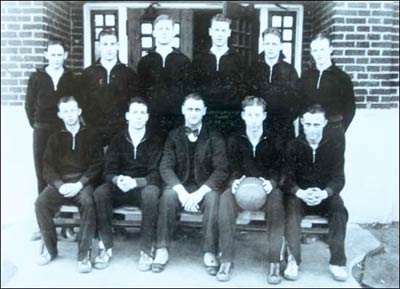
Back row, second guy from the right -- could that be Wayne Houdyshell? About Wayne Houdyshell: Vance Houdyshell wrote from Florida about a photo of an early Pawnee Rock High School basketball team. Some of the players were tentatively identified. "I looked at the basketball team photo and noticed a Darrell Houdyshell. I haven't heard of him, but Wayne Houdyshell played semi-pro basketball." The curve of Kansas
[June 1] We learned in grade school that the earth, even Kansas, was not flat. If you were like me, you might have been determined to prove that to yourself from atop Pawnee Rock State Park's pavilion. Yes, it's a gentle curve, but if you look at the space between Radium and Great Bend, the horizon does seem to bend. (The hills near Larned and north of Dundee ruin the effect if you look that way, and the elevators of Pawnee Rock interrupt the southern horizon.) That little moment of my scientific education came back to me when I was flipping through some photos I had taken from atop the bins on the Farmers Grain elevator. I was about 100 feet above downtown Pawnee Rock, which meant that I was higher than the observation deck on the pavilion at the Rock. The horizon appears curved in the photo because I angled my camera slightly downward to capture details close to the elevator. The elevator is the tallest point along our Arkansas River valley highway for about 20 miles in one direction and 8 in the other. I felt as if I were on top of the world. And who knows -- maybe I really did see the curve of the earth from up there. Technically, I did. This page says that a 100-foot-tall object that is 15 miles away will be below the horizon of someone standing on the ground. Because the earth is a sphere, it must have the same amount of curvature from side to side. So, if you're on top of the Rock on a clear day, you might be able to discern that curvature. Isn't it cool when our grade school science education is vindicated? |
Sell itAdvertise here to an audience that's already interested in Pawnee Rock: Or tell someone happy birthday. Advertise on PawneeRock.org. |
|
|

 Last night, I looked back through a couple of well-creased, handed-down
Last night, I looked back through a couple of well-creased, handed-down 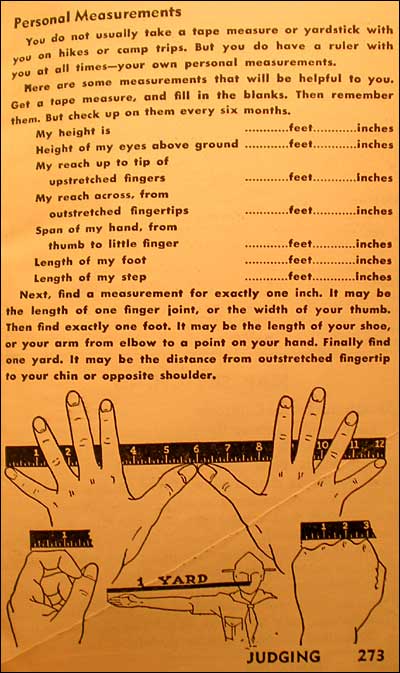
 The wave of harvesters -- custom cutters with muscular combines -- one day appeared on U.S. 56, K-19, and the county roads. A couple of farmers with dry fields and dry grain began to mow their own fields, and suddenly harvest was everywhere. Pawnee Rock was at the cutting edge of the race against rain, heat, and hail.
The wave of harvesters -- custom cutters with muscular combines -- one day appeared on U.S. 56, K-19, and the county roads. A couple of farmers with dry fields and dry grain began to mow their own fields, and suddenly harvest was everywhere. Pawnee Rock was at the cutting edge of the race against rain, heat, and hail. The stone church mentioned in the article sat near where the Dundee Valley Cemetery does, south of the highway and near the site of the historical marker. was destroyed in the 1950s by a tornado, many years after the congregation had moved to a frame church north of Pawnee Rock. The Dundee Valley Cemetery, which is now the home of many of these settlers, is hemmed in by a sandpit. The old farms and property lines have fallen to age and the plow, and Dundee itself doesn't bear any overtly Mennonite trace in the ways that distinguish other Mennonite-settled towns, such as Yoder.
The stone church mentioned in the article sat near where the Dundee Valley Cemetery does, south of the highway and near the site of the historical marker. was destroyed in the 1950s by a tornado, many years after the congregation had moved to a frame church north of Pawnee Rock. The Dundee Valley Cemetery, which is now the home of many of these settlers, is hemmed in by a sandpit. The old farms and property lines have fallen to age and the plow, and Dundee itself doesn't bear any overtly Mennonite trace in the ways that distinguish other Mennonite-settled towns, such as Yoder. The fifteen cottages formed a village, and near the center of this was built a stone school house, which also served as a church building. The ruler or head officer was called "the schultz," and for convenience he had his home near the school building, and his residence served as a council house. Abraham Seibert was the first pastor of this Mennonite congregation but he was not a resident of the villege, but lived with his parents about two miles southeast of the settlement, and now lives in Michigan.
The fifteen cottages formed a village, and near the center of this was built a stone school house, which also served as a church building. The ruler or head officer was called "the schultz," and for convenience he had his home near the school building, and his residence served as a council house. Abraham Seibert was the first pastor of this Mennonite congregation but he was not a resident of the villege, but lived with his parents about two miles southeast of the settlement, and now lives in Michigan. Last winter, I won some railroad passes during a festival. My wife still isn't up to traveling, so midweek I squired the boys to Denali National Park. We didn't go to see Mount McKinley or the moose or bears -- we went just for the fun of riding the train eight hours up and eight hours back over two days.
Last winter, I won some railroad passes during a festival. My wife still isn't up to traveling, so midweek I squired the boys to Denali National Park. We didn't go to see Mount McKinley or the moose or bears -- we went just for the fun of riding the train eight hours up and eight hours back over two days. And there she stood in the drizzle, holding her car keys and her infant son and engaging Sam about homeschool.
And there she stood in the drizzle, holding her car keys and her infant son and engaging Sam about homeschool. Save the sign? Ray Randolph wrote to suggest that the
Save the sign? Ray Randolph wrote to suggest that the  You might think of making a pebble go farther and straighter than you could ever throw it. You might have thought that you were suddenly a great hunter of rabbits and squirrels and sparrows even if all you could do at the moment was whack some tree trunks and puncture the giant green leaves of the elephant ear plant in the back yard.
You might think of making a pebble go farther and straighter than you could ever throw it. You might have thought that you were suddenly a great hunter of rabbits and squirrels and sparrows even if all you could do at the moment was whack some tree trunks and puncture the giant green leaves of the elephant ear plant in the back yard. "I love the Pawnee Rock website and would like to add to the
"I love the Pawnee Rock website and would like to add to the  [June 3] Jim Dye has been photographing a lot of wildflowers, and as soon as I can get a couple of free hours I'm going to create a wildflower section for our site. In the meantime, I want to point out a cool site that catalogs the plants and animals down to your ZIP code.
[June 3] Jim Dye has been photographing a lot of wildflowers, and as soon as I can get a couple of free hours I'm going to create a wildflower section for our site. In the meantime, I want to point out a cool site that catalogs the plants and animals down to your ZIP code.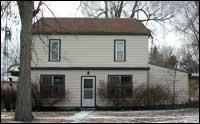 "The
Holland family lived in the big house on the corner to the east of Lucy's house.
The Holland daughters all married and lived in a row along that block -- Lela Holland married Cecil Gilbert and lived next door to her parents. The house next to her was lived in by Lucy and William Houdyshell.
"The
Holland family lived in the big house on the corner to the east of Lucy's house.
The Holland daughters all married and lived in a row along that block -- Lela Holland married Cecil Gilbert and lived next door to her parents. The house next to her was lived in by Lucy and William Houdyshell.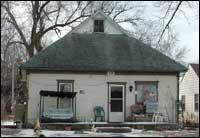 "Next to them, and on the corner, lived sister Buena and her husband, Earl Bowman. Dick, one of their children, lived at home with them throughout his life.
"Next to them, and on the corner, lived sister Buena and her husband, Earl Bowman. Dick, one of their children, lived at home with them throughout his life.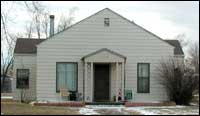 "William Houdyshell was painting a house north of Rozel when he developed a headache. The homeowner
accidentally gave him strychnine instead of aspirin. He died from that on 4/19/1906 at the young age of 27, leaving his wife Lucy with three very young boys to raise on her own.
"William Houdyshell was painting a house north of Rozel when he developed a headache. The homeowner
accidentally gave him strychnine instead of aspirin. He died from that on 4/19/1906 at the young age of 27, leaving his wife Lucy with three very young boys to raise on her own.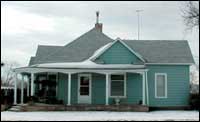 "It was then that she opened Lucy's Dress Shop out of that home that is pictured there on the May 30 entry. She worked very hard and was very successful in her shop, as well as very successfully raising three fine boys.
"It was then that she opened Lucy's Dress Shop out of that home that is pictured there on the May 30 entry. She worked very hard and was very successful in her shop, as well as very successfully raising three fine boys.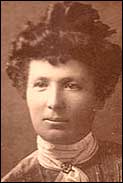 Jacqueline, my mother. Vin did work in the drug store in Pawnee Rock, eventually owning it. He then also worked in Larned at Brock's Drug Store, and he then bought it. Together with Glenda, they ran the very successful Vin's Pharmacy for years until they eventually sold it to Ritzman's. My mother, Jacqueline, worked at Vin's Pharmacy at the soda fountain for years, my grandmother Glenda ran the business end of the store, and my grandfather was the pharmacist.
Jacqueline, my mother. Vin did work in the drug store in Pawnee Rock, eventually owning it. He then also worked in Larned at Brock's Drug Store, and he then bought it. Together with Glenda, they ran the very successful Vin's Pharmacy for years until they eventually sold it to Ritzman's. My mother, Jacqueline, worked at Vin's Pharmacy at the soda fountain for years, my grandmother Glenda ran the business end of the store, and my grandfather was the pharmacist.